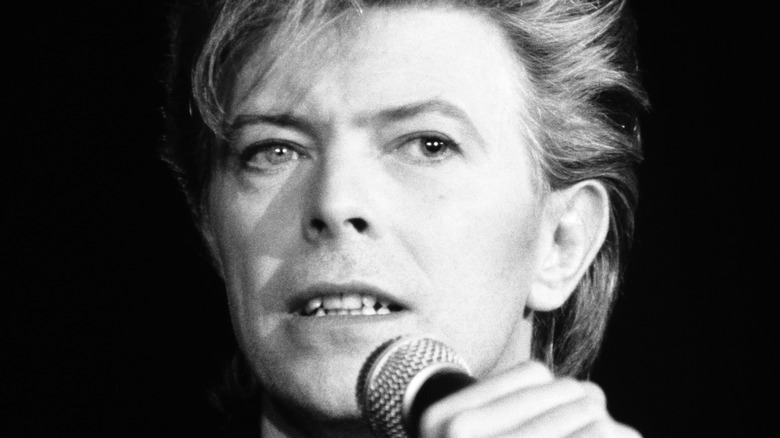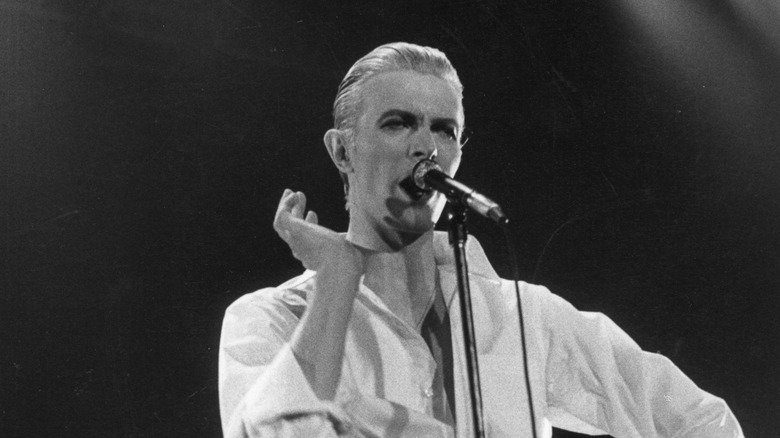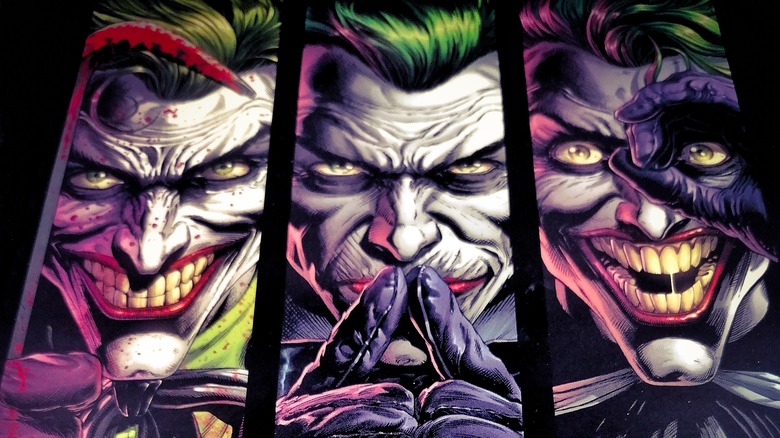How David Bowie Helped Shape The Image Of DC's Staple Villain
David Bowie is one of the most recognizable musicians of all time. His music career spanned five decades and covered multiple genres, including rock and soul. He is also well known for the personas that he would take on, with his most famous being Ziggy Stardust from the early 1970s. Still, despite this success, Bowie had a hard time breaking into the mainstream in the United States. Bowie said (via Far Out Magazine), "Adapting to the idea of being mainstream I found very difficult indeed. I was beaten by the whole three-ring circus about it. I tried to reach a wider and wider audience without actual feelings of artistic passion."
According to Billboard, Bowie only ever had two singles reach No. 1 in the charts in America — "Fame" in 1975 and "Let's Dance" in 1983 — and he didn't have a No. 1 album until the release of "Blackstar" in 2016. Despite his lack of commercial success in the states, Bowie's influence is obvious in artists that followed in his footsteps. And while it's not as obvious as his impact on music, Bowie also had an influence over the reimagining of arguably DC Comic Books' most famous villain.
Various personas
Similar to how David Bowie used multiple personas throughout his career, there are countless incarnations of Batman's main rival, the Joker, throughout the Batman comics. Each writer for the comics has their own personal spin and inspiration for their version of the Joker, and Bowie served as the inspiration for not just one but two writers of the hit comic series in the 1980s.
Frank Miller's 1986 "The Dark Knight Returns" features a new, darker Joker. According to Far Out Magazine, when writing his Joker, Miller had David Bowie in mind, and Bowie's cover art for his 1980 album, "Scary Monsters (and Super Creeps)," influenced the Joker's new look. Miller's version of the Joker also displayed many of Bowie's mannerisms, including casual cigarette smoking and the use of the word "darling" (via CBR.com). In an interview with IGN, Miller said, "Yeah, if I had to cast the Joker from Dark Knight, I probably would have used David Bowie, who I think was capable of great menace." While there were some discussions of a screenplay adaptation back in the 1980s, with Bowie in consideration for the Joker role, it never came to fruition (via Far Out Magazine). In an interview with EW, Jared Leto claims that his portrayal of the Joker in "The Suicide Squad" was also inspired by Bowie, saying that it was "not necessarily the music of David, but his class, his elegance, his timelessness."
Though Miller's Joker was the first Bowie-inspired version, it wouldn't be the last.
Thin White Duke
Grant Morrison began writing for the "Batman" comic book series with the 1989 release of "Arkham Asylum: A Serious House on Serious Earth," in which he introduced the concept of super-sanity (via CBR.com). This concept explained the Joker's madness not as evil or crazy, but rather that he has reached a new level of sanity and creates personas — much like Bowie did during his career — to deal with his view of the world. While Miller's references to Bowie were subtle, Morrison makes a direct connection between the two.
One of Bowie's personas following the retirement of Ziggy Stardust was the Thin White Duke. Appearing alongside the 1976 release of "Station to Station," the Thin White Duke — who had slicked back hair and wore white shirts, scarves, suspenders, and waistcoats — was inspired by Bowie's first major film role in "The Man Who Fell to Earth" (via ABC News). One of the personas that Morrison's Joker takes on is that of the "Thin White Duke of Death." This version of the Joker reappears after being shot in the face by a fake Batman with slicked-back hair, suspenders, and mismatched eyes, all direct references to Bowie (according to The Cut, Bowie had anisocoria, a condition that causes a person's pupils to be different sizes and appear different colored). Bowie had a very unique personality and incredible talent, so it's not a surprise that his influence ranged far beyond just music.


